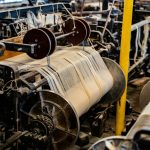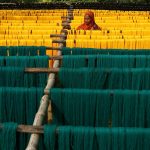You’ll find jute is a highly sustainable fabric because it uses less water and energy than cotton and synthetics, thrives with minimal chemicals, and enriches soil. It’s biodegradable and supports millions of farmers in rural areas, promoting fair trade and local economies. While some challenges like fluctuating prices exist, ongoing innovations improve its environmental and social benefits. If you want to understand the full picture of jute’s sustainability, there’s much more to explore.
Table of Contents
Key Takeaways
- Jute is biodegradable, durable, and requires minimal pesticides, making it an eco-friendly fabric choice with a low environmental footprint.
- It needs significantly less water than cotton, consuming about 2,000 liters per kg compared to cotton’s 10,000 liters.
- Jute farming enriches soil with organic matter and relies on rainfed conditions, reducing water and chemical inputs.
- Processing jute uses less energy than synthetic fibers, often utilizing renewable biomass, lowering greenhouse gas emissions.
- Socioeconomic benefits include supporting rural livelihoods and poverty reduction, though challenges like market instability and labor safety remain.
Overview of Jute Fiber and Its Uses
Jute fiber, often called the “golden fiber,” is a natural plant fiber known for its strength and versatility. When you use jute, you’re working with a material that’s both durable and biodegradable.
It’s commonly found in products like sacks, ropes, and rugs, offering sturdy alternatives to synthetic fibers. You’ll also see jute in fashion accessories, home décor, and eco-friendly packaging.
Its coarse texture makes it excellent for items needing toughness, yet it can be blended with other fibers for softer fabrics. Because jute can be woven into various forms, you get a fabric that’s both functional and stylish.
Choosing jute means opting for a fiber that supports multiple uses without compromising environmental responsibility.
Cultivation Practices and Environmental Effects
Although cultivating jute requires specific conditions, it generally demands fewer chemical inputs than many other crops. When you grow jute, you’ll notice it thrives in warm, humid climates with well-drained soil, usually near riverbanks.
Farmers often use minimal pesticides and synthetic fertilizers, which helps reduce soil and air pollution. Jute crops also enrich the soil by adding organic matter when the leftover plant material decomposes.
However, you should be aware that improper land management can lead to soil erosion or loss of biodiversity. Still, compared to synthetic fibers or heavily fertilized crops, jute’s cultivation has a relatively low environmental footprint.
Water Consumption in Jute Farming
Farming practices that minimize chemical use often also impact water needs. When you grow jute, you’ll find it requires considerably less water than cotton. Jute thrives in rainfed areas and doesn’t need extensive irrigation, making it a low-water crop. This means you save water resources while still producing a strong, durable fiber. Here’s a quick comparison to help you see the water consumption differences:
| Crop | Water Needed per kg Fiber (Liters) | Irrigation Dependency |
|---|---|---|
| Jute | 2,000 | Low |
| Cotton | 10,000 | High |
| Hemp | 3,300 | Medium |
| Flax | 2,700 | Medium |
Choosing jute helps you reduce water use in textile production considerably.
Impact of Pesticides and Fertilizers on Ecosystems
When you choose fibers grown with minimal pesticides and fertilizers, you protect local ecosystems from harmful chemical runoff and soil degradation.
Jute cultivation typically requires fewer chemical inputs than many other crops, reducing the chance of contaminating nearby water bodies and harming aquatic life.
Jute cultivation’s low chemical use helps protect water bodies and supports aquatic ecosystems.
Excessive pesticide use can disrupt soil biodiversity, killing beneficial insects and microorganisms essential for nutrient cycling.
Fertilizer overuse often leads to nutrient leaching, causing algal blooms that deplete oxygen in water, threatening fish and other species.
By supporting jute farming practices that limit these chemicals, you help maintain healthier soil and water quality.
This careful balance guarantees jute remains an eco-friendly fabric choice that safeguards the environment without compromising agricultural productivity.
Energy Usage in Jute Processing and Manufacturing
When you look at jute processing, you’ll notice the energy sources used and how efficiently factories run can greatly affect its sustainability.
You’ll want to compare the energy consumption of jute manufacturing to other textiles to get a clearer picture.
Understanding these factors helps you see if jute truly stands out as an eco-friendly fabric.
Energy Sources Utilized
In examining the energy sources utilized during jute processing and manufacturing, you’ll find that the industry primarily relies on both traditional and modern power options. Traditional sources like biomass and coal remain common, especially in rural areas, while electricity and natural gas are increasingly used in more industrialized setups. This mix impacts the environmental footprint of jute production. Here’s a quick comparison:
| Energy Source | Usage Context | Environmental Impact |
|---|---|---|
| Biomass | Rural processing units | Renewable, low CO2 |
| Coal | Older factories | High emissions |
| Electricity | Modern plants | Depends on generation |
| Natural Gas | Industrial facilities | Cleaner than coal |
Understanding these sources helps you grasp jute’s overall sustainability profile.
Manufacturing Energy Efficiency
Although energy sources vary across jute processing facilities, you’ll find that improving manufacturing energy efficiency remains a key focus to reduce costs and environmental impact.
When you look closely at jute production, energy-intensive steps like retting, fiber extraction, and spinning demand careful management. By optimizing machinery and adopting energy-saving technologies, you can greatly cut electricity consumption during these stages.
Many manufacturers also implement routine maintenance to keep equipment running smoothly, preventing energy waste. Additionally, you can improve efficiency by adjusting operational schedules to off-peak hours or integrating waste heat recovery systems.
These measures not only lower your carbon footprint but also enhance overall productivity. Focusing on energy efficiency in manufacturing helps guarantee jute remains a sustainable fabric choice for the future.
Comparative Energy Consumption
Since energy consumption varies widely among fabrics, comparing jute’s processing energy gives you a clearer picture of its sustainability. Jute requires considerably less energy than synthetic fibers, making it an eco-friendlier option. When you look at cotton or polyester, their energy demands during cultivation and manufacturing far exceed jute’s. This difference impacts your choice if you want to reduce your carbon footprint.
| Fabric | Energy Use (MJ/kg) | Notes |
|---|---|---|
| Jute | 4 | Minimal processing energy |
| Cotton | 55 | High irrigation and processing |
| Polyester | 125 | Derived from fossil fuels |
| Hemp | 7 | Moderate energy needs |
| Nylon | 80 | Energy-intensive polymerization |
Choosing jute helps you lower energy consumption in textile production.
Biodegradability and End-of-Life Options for Jute Products
When you dispose of jute products, you’ll find they break down naturally and quickly compared to synthetic fabrics. Jute fibers decompose in a matter of months under the right conditions, leaving no harmful residues behind.
This biodegradability makes jute an eco-friendly option for single-use or short-lifespan items. At the end of their life, you can compost jute bags, rugs, or upholstery covers, returning nutrients back to the soil.
If you can’t compost them, recycling jute into new products is another viable option, reducing waste and conserving resources. Avoid sending jute to landfills where decomposition slows due to lack of oxygen.
Comparison of Carbon Footprints: Jute vs. Other Natural Fibers
Three key natural fibers—jute, cotton, and hemp—stand out when you compare their carbon footprints.
Jute generally has a lower carbon footprint because it requires less water, fewer pesticides, and minimal fertilizer. You’ll find jute absorbs carbon dioxide rapidly during growth, helping offset emissions.
Cotton, on the other hand, often demands intensive irrigation and agrochemicals, increasing its emissions considerably.
Hemp falls between the two, needing moderate inputs but boasting fast growth and high yields that improve its carbon efficiency.
When you choose jute over cotton, you’re selecting a fiber with a smaller environmental impact, especially regarding greenhouse gas emissions.
This makes jute a strong contender if you’re aiming for sustainable fabric options with a reduced carbon footprint.
Socioeconomic Benefits and Challenges in Jute-Producing Regions
Understanding the environmental advantages of jute is only part of the story; the fabric’s impact on local communities also matters. When you support jute production, you contribute to the livelihoods of millions of smallholder farmers and artisans, especially in countries like Bangladesh and India.
Jute cultivation creates jobs, promotes rural development, and helps reduce poverty. However, you should also recognize challenges such as fluctuating market prices, limited access to modern technology, and vulnerability to climate change, which can affect farmers’ incomes and crop yields.
Additionally, labor conditions in some processing units may lack adequate safety measures. By being aware of these socioeconomic factors, you can better understand the full picture of jute’s sustainability and the importance of supporting fair trade and community-focused initiatives in jute-producing regions.
Innovations and Improvements in Sustainable Jute Production
Although jute has long been valued for its eco-friendly qualities, recent innovations are making its production even more sustainable and efficient.
You’ll find that advances in natural pest control reduce chemical use, protecting both the environment and farmers’ health. Improved retting methods, like microbial retting, cut down water pollution and speed up fiber extraction.
Plus, researchers are developing jute varieties that require less water and resist pests better, so you don’t have to worry about heavy resource consumption.
On top of that, mechanization in harvesting and processing boosts productivity while minimizing waste.
Frequently Asked Questions
How Does Jute Fabric Feel Compared to Cotton or Linen?
You’ll find jute fabric feels coarser and rougher than cotton or linen. It’s less soft but more textured, giving a natural, rustic vibe. Cotton feels smooth, while linen is crisp and breathable in comparison.
Can Jute Fabric Be Dyed Easily With Natural Dyes?
You might think jute resists natural dyes, but it actually absorbs them well. Just remember its coarse texture can cause uneven coloring, so you’ll need patience and proper mordants for vibrant, lasting results.
Is Jute Fabric Suitable for Clothing or Only for Bags and Upholstery?
You can definitely use jute fabric for clothing, but it’s coarser and less flexible than cotton, so it’s better suited for bags and upholstery. For wearable items, you might want softer blends or treatments to improve comfort.
How Long Does Jute Fabric Typically Last With Regular Use?
You might think jute fabric lasts forever, but with regular use, it typically holds up well for 1-3 years. You’ll want to handle it gently, though, because it’s not as tough as synthetic fabrics.
Are There Any Common Allergens Associated With Jute Fabric?
You might find that jute fabric can cause mild skin irritation or allergic reactions in sensitive individuals due to its coarse texture and natural oils. It’s best to test a small area before prolonged contact.
- Using White Polyamide for 3D Printing Gaming Miniatures - June 30, 2025
- Can Polyamide-Imide Be Used as a Concrete Additive? An Exploration - June 30, 2025
- A Guide to Injection Molding With Polyamide (Nylon) - June 30, 2025







